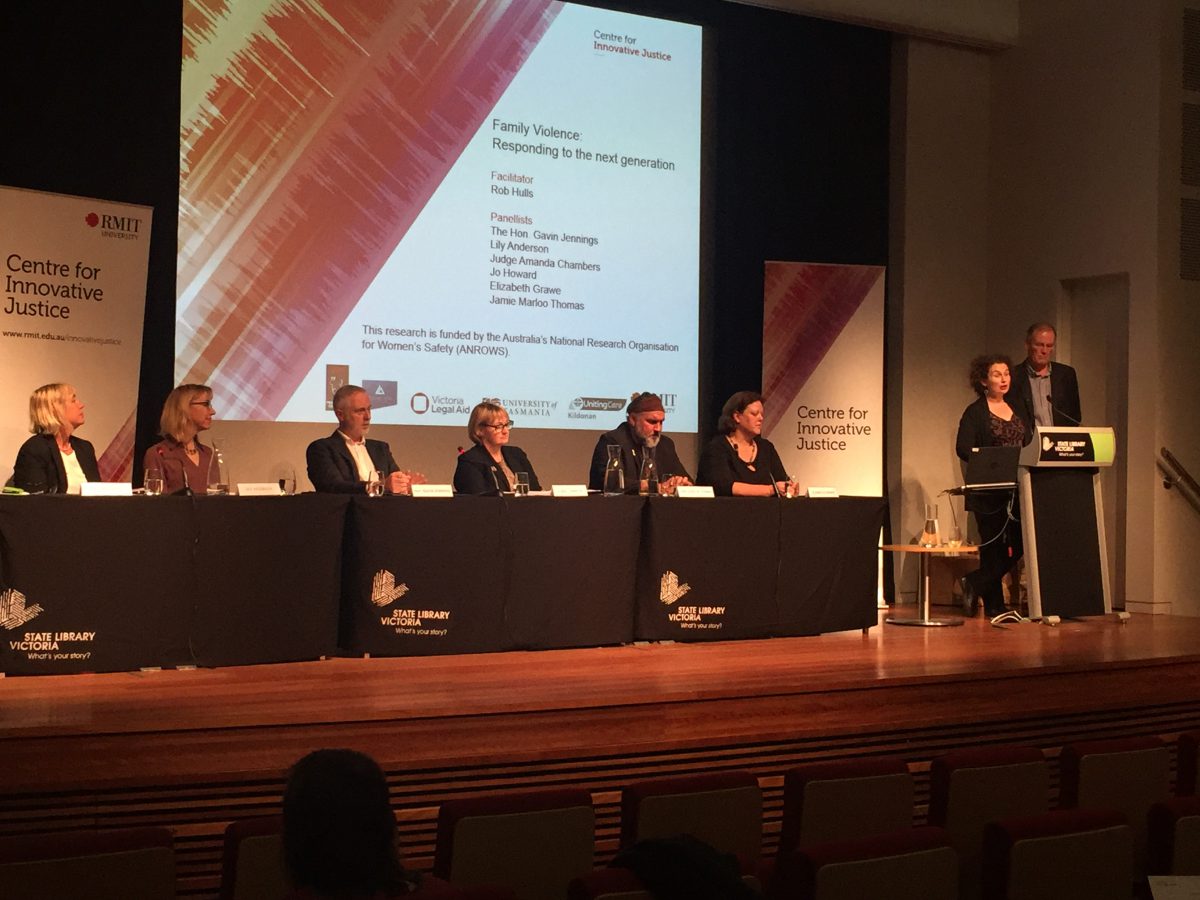Family violence: responding to the next generation
Amidst the array of family violence reform across Australia, how does an issue like adolescent family violence rate?
PIPA Forum panel members left to right: Jo Howard, Kildonan, Lily Anderson, Step Up Program USA, The Hon Gavin Jennings, Special Minister of State, Jamie Marloo Thomas, Wayapa Wuurrk Aboriginal Wellness Foundation, Elizabeth Grawe, parent with direct experience of AVITH , Elena Campbell and Rob Hulls
By Elena Campbell, Associate Director, Research, Advocacy and Policy, CIJ
Amidst the array of family violence reform across Australia, how does an issue like adolescent family violence rate? Is it really something on which we can afford to focus, when we already have so much work on our policy plates?
Far from peripheral, adolescent violence in the home (AVITH) is a very real issue for many working in and around the broader response to family violence. Certainly, throughout the development of the CIJ’s 2015 report, Opportunities for early intervention: bringing perpetrators of family violence into view, the CIJ heard consistently that (a) adolescent violence was a huge concern; (b) there was no considered response to it and (c) there was no opportunity to shape such a response.
Accordingly, the CIJ decided to develop a project which created this opportunity – the chance not only to understand the challenge, but to work towards a considered solution. In collaboration with colleagues across the sector and in other jurisdictions, the CIJ applied for and received funding under the Perpetrator Interventions Stream from ANROWS, Australia’s National Research Organisation for Women’s Safety.
The result is the PIPA Project, or Positive Interventions for Perpetrators of Adolescent violence in the home (AVITH). This two year project involves dual strands – the first conducting research across Victoria, Tasmania and Western Australia which will enable us to understand the prevalence and contributing factors, as well as the kinds of responses that it currently receives in different legislative and regulatory regimes. This includes the Tasmanian regime, which currently only recognizes intimate partner violence. Meanwhile, the second strand focuses on the relevant recommendations of the Victorian Royal Commission into Family Violence – their implementation and relevant barriers; and the opportunities which need to be seized in order to work towards a considered response.
As part of this project, the CIJ recently hosted a public forum at the State Library of Victoria, the details of which can be found in our newsletter, with a link to the audio provided here. Over 100 people turned out on a freezing Melbourne night and heard this expert and diverse panel paint a vivid picture of what Special Minister Gavin Jennings remarked at the time was ‘as complex a challenge as you can imagine’.
This complexity derives in part from the fact that the primary victims of violence in this context are also the primary carers for those using the violence. What’s more, these carers are not only responsible for the welfare of the adolescent using violence, but for the welfare of their other children. In this equation, it is not surprising to hear that parents put their own welfare last – only resorting to calling the police after months or even years of violent behavior – simply because they want the violence to stop.
What happens in this situation, though? What prompts a family to call the police? What happens when they do? Answers to these questions remain regrettably elusive across jurisdictions. Police face tough judgment calls when they respond to an incident in which a parent does not want their child arrested. If the police do remove the child, there are few places to take him/her, and often the police response may involve simply sitting at the police station ringing around relatives just to find somewhere to place the child for the night.
If the child has committed chargeable offences, bail or diversionary options may not be available simply because the family does not feel that it is safe to have the young person home. This means being remanded and exposed to the criminogenic environment of custody. If children attend court as respondents to an intervention order, the programs which are available to help them and their family are confined to specific locations, with Magistrates also unable to mandate attendance for a cohort which is already incredibly difficult to engage.
Back home and feeling isolated and often ashamed, meanwhile, parents can now access more support than in the past, but support for their other children appears sorely lacking, as are opportunities for simple respite – a chance for families to catch their breath before their challenging adolescent returns home.
Without a doubt, implementation of the relevant Royal Commission recommendations will make a difference in Victoria – recommendations which include expansion of behavior change programs, increases in accommodation, support for victims and perpetrators at court, and expansion of diversion amongst others. These will also function as an example for other jurisdictions.
What the PIPA Project aims to do, however, is anticipate how these will work in practice, what the gaps are and how they can be more effectively linked. Using the findings from the first strand, the Project will feed this expanding evidence about prevalence and contributing factors up to senior levels and keep the issue of AVITH firmly on the policy radar.
In doing so the project aims to remind us that, amidst all the current policy frenzy, we have an obligation to respond to the next generation – adolescents who, in many cases may be using violence against their families simple because that is what they have learned; adolescents who are experiencing other challenges and who have not received appropriate support; adolescents who may well hit the service system as more entrenched offenders, unless we learn how to step in earlier and effectively respond.
